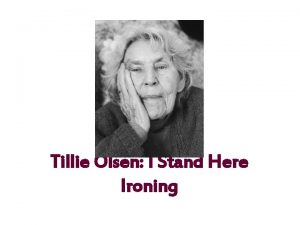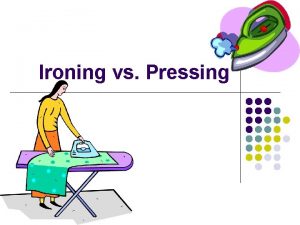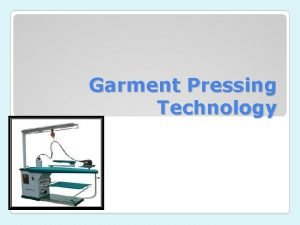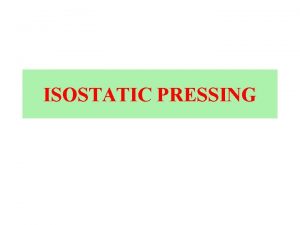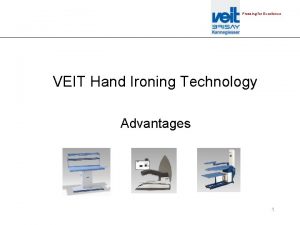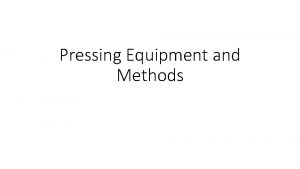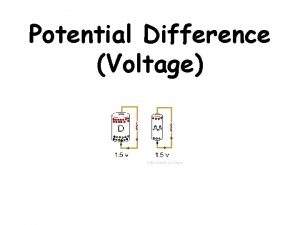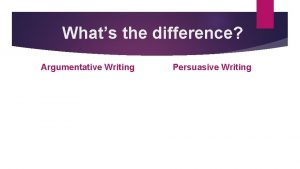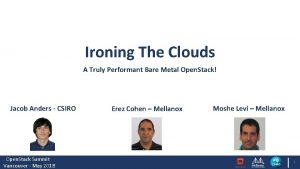Ironing or Pressing Whats the difference Pressing Ironing




















- Slides: 20

Ironing or Pressing. . . What’s the difference?

Pressing Ironing “Ironing” is done with a back and forth motion. (Ironing can cause fabric to stretch) Ironing is the process of removing wrinkles from damp, washable clothing. Heat and pressure are used to flatten the fabric. “Pressing” is a lifting & lowering motion, gradually overlapping until the area is covered. Pressing involves no sliding of the iron. The iron is placed on the fabric and then lifted. Moisture is added from a pressing cloth or steam in the iron. This is good for wool and loose/bulky textures. It is often done to apparel before wearing. It is also done while constructing garments.

Why is it important? ● Often it is pressing that makes the difference between a professionallooking garment and one that looks homemade. ● Fabric grainlines can be improved & straightened. ● Removing creases and wrinkles before cutting ensures that the pieces will be cut to the right size. ● Makes the construction process easier.

1. You should always use _____ water in irons because ________. . . You should always use distilled water in irons because it reduces mineral build up and makes the iron last longer.

2. Explain the temperature settings on the dial of most irons. Most irons have a chart that indicates the correct temperature settings for various fibers. To use the chart, you must know the fiber content of your fabric. For fiber blends, use the temperature suited to the most heat sensitive fiber in the fabric. Low - Synthetics Medium - Wool and Silk Linen High - Cotton &

3. What is the purpose of a pressing cloth? To prevent shine or iron marks on fabric.

4. Why is it important to iron with the grain of the fabric? To prevent stretching the fabric out of shape.

5. When ironing a garment, you should start with. . . the small areas (collar & cuffs) followed by the back and finished with the front.

6. Why should you iron dark, dull fabrics on the wrong side? To prevent shiny spots!

7. Why would you want to have cotton and linen be damp? They wrinkle too much to press well without being damp. It relaxes the fibers, so that they can be smoothed out and/or flattened.

8. The cardinal rule in sewing is “Press as you go”. What does this mean? To press each seam as it is sewn, before stitching adjoining or crossing seams.

9. Why should you press seams flat before pressing them open? It flattens and sets the stitches so that the seam lays smooth.

10. Why use a needle board on velvets, velveteens, and corduroy? The raised nap would flatten out and become shiny without a needle board.

11. Using a lifting and lowering motion is pressing. Using a sliding motion is ironing.

12. How should fusibles be applied? The side of the fusible with the glue/adhesive should be placed on the wrong side of the fabric. Press and hold for 10 -15 seconds using a pressing cloth and steam.

13. How should a straight seam usually be pressed? Flat and then open.

Identify the following pressing tools and tell what their purpose is… Sleeveboard For ironing or pressing enclosed seams, such as sleeves.

Needleboard To preserve the nap of velvets and corduroys.

Point Presser For point areas such as collars and cuffs.

Tailor’s Ham For pressing darts and curved seams.
 Cold ironing regulations
Cold ironing regulations Ironed out mastoid
Ironed out mastoid How is she doing
How is she doing What is the theme of i stand here ironing
What is the theme of i stand here ironing Hope semester 1 exam answers
Hope semester 1 exam answers Extreme ironing
Extreme ironing Hình ảnh bộ gõ cơ thể búng tay
Hình ảnh bộ gõ cơ thể búng tay Slidetodoc
Slidetodoc Bổ thể
Bổ thể Tỉ lệ cơ thể trẻ em
Tỉ lệ cơ thể trẻ em Chó sói
Chó sói Thang điểm glasgow
Thang điểm glasgow Hát lên người ơi alleluia
Hát lên người ơi alleluia Các môn thể thao bắt đầu bằng từ đua
Các môn thể thao bắt đầu bằng từ đua Thế nào là hệ số cao nhất
Thế nào là hệ số cao nhất Các châu lục và đại dương trên thế giới
Các châu lục và đại dương trên thế giới Cong thức tính động năng
Cong thức tính động năng Trời xanh đây là của chúng ta thể thơ
Trời xanh đây là của chúng ta thể thơ Cách giải mật thư tọa độ
Cách giải mật thư tọa độ Làm thế nào để 102-1=99
Làm thế nào để 102-1=99 Phản ứng thế ankan
Phản ứng thế ankan



